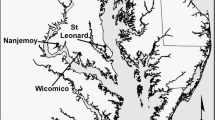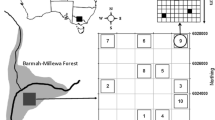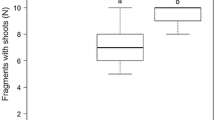Abstract
Hydrology, which filters propagule bank expression, differs among Carolina bay wetlands. We examined the relationships among hydrology, recruitment from the propagule bank, and bay vegetation over one season in six herbaceous bays that differ in hydroperiod. Sediment cores were taken at distances from each bay center representing 10%, 25%, 50%, and 75% full water level and subjected to flooded, midsummer drawdown, or moist soil conditions in an outdoor mesocosm experiment. Vegetation from the cores was compared among hydrology treatments and with bay vegetation. In bay vegetation, species richness and dissimilarity, calculated among replicate plots at each distance, increased from flooded bay centers toward the margins, where water level fluctuated. Among bays, vegetation richness increased from more pond-like bays to the flashiest bay. Within bays, vegetation graded from obligate wetland species to a mixture of obligate and facultative species from center to margin. The flooding treatment promoted convergence on obligate wetland floating-leaved and emergent species, low species richness, and high community similarity of vegetation from the sediment cores. Our research supports the hypothesis that hydrology filters recruitment and species distribution in Carolina bays. The extent of inundated, fluctuating water, and exposed sediment areas can determine seasonal vegetation organization in such wetlands. Vegetation in wetlands with steep basins and stable hydrology is more likely zoned; dominant species show discontinuous distributions along the flooding gradient. In contrast, fluctuating hydrology in shallow basins results in unzoned vegetation, with more continuous species distributions from wetland center toward the margins.
Similar content being viewed by others
Abbreviations
- KW:
-
Kruskal-Wallis
- SAS:
-
Statistical Analysis System
- SREL:
-
Savannah River Ecology Laboratory
- SRS:
-
Savannah River Site
References
Bauder, E. T. 1989. Drought stress and competition effects on the local distribution of Pogogyne abramsii. Ecology 70:1083–1089.
Bennett, S. H. and J. B. Nelson. 1991. Distribution and status of Carolina bays in South Carolina. Nongame and Heritage Trust Publications No. 1. South Carolina Wildlife and Marine Resources Department, Columbia SC.
Bertness, M. D. and S. M. Yeh. 1994. Cooperative and competitive interactions in the recruitment of marsh elders. Ecology 75:2416–2429.
Blom, C. W. P. M. and L. A. C. J. Voesenek. 1996. Flooding: the survival strategies of plants. TREE 11:290–296.
Boutin, C. and P. A. Keddy. 1993. A functional classification of wetland plants. J. Veg. Sci. 4:313–348.
Brinson, M. M. 1993. A hydrogeomorphic classification for wetlands. Wetlands Research Program Technical Report WRP-DE-4. U. S. Army Corps of Engineers Waterways Experiment Station.
Collins, B. S. and G. R. Wein. 1995. Seed bank and vegetation of a constructed reservoir. Wetlands 15:374–385.
De Steven, D. 1994. Patterns of vegetation diversity among Carolina bays and depression wetlands on the Savannah River Site, South Carolina. Unpub. Report. 35 pp.
De Steven, D. and M. Toner. 1997. Gradient analysis and classification of Carolina bay vegetation: a framework for bay wetlands conservation and restoration. Unpub. Report for U.S.D.A. Forest Service. 53 pp.
Gerritsen, J. and H. S. Greening. 1989. Marsh seed banks of the Okefenokee swamp: effects of hydrologic regime and nutrients. Ecology 70:750–763.
Grace, J. B. 1990. On the relationship between plant traits and competitive ability. In: J. B. Grace and D. Tilman (eds), Perspectives on Plant Competition. Academic Press, San Diego, CA., pp. 51–65.
Grace, J. B. and R. G. Wetzel. 1998. Long-term dynamics of Typha populations. Aquatic Bot. 61:137–146.
Hacker, S. D. and M. D. Bertness. 1999. Experimental evidence for factors maintaining plant species diversity in a New England salt marsh. Ecology 80:2064–2073.
Hoagland, B.W. and S. L. Collins. 1997. Heterogeneity in shortgrass prairie vegetation: the role of playa lakes. J. Veg. Sci. 8:277–286.
Johnson, W. C., T. L. Sharik, R. A. Mayes, and E. P. Smith. 1987. Nature and cause of zonation discreteness around glacial prairie marshes. Can. J. Bot. 65:1622–1632.
Keddy, P. A. 1983. Shoreline vegetation in Axe Lake, Ontario: effects of exposure on zonation patterns. Ecology 64:331–344.
Keddy, P. A. 2000. Wetland Ecology: Principles and Conservation. Cambridge University Press. Cambridge, UK.
Keddy, P. A. and P. MacLellan. 1990. Centrifugal organization in forests. Oikos 59:75–84.
Keddy, P. A. and A. A. Reznicek. 1982. The role of seed banks in the persistence of Ontarios Coastal Plain flora. Amer. J. Bot. 69:13–22.
Kelley, W. R. and W. T. Batson. 1955. An ecological study of the land plants and cold-blooded vertebrates of the Savannah River Project area. Part VI. Conspicuous vegetational zonation in a ACarolina bay.@ University of South Carolina Publication, Biology Series III, 1.
Keough, J., G. R. Guntenspergen, and J. Grace. 1989. Vegetation and hydrologic characteristics of Carolina bays. Unpub. Report for the Savannah River Ecology Laboratory, SRS.
Kirkman, L. K., 1992. Cyclical Vegetation Dynamics in Carolina Bay Wetlands. PhD Thesis, University of Georgia. Athens, GA.
Kirkman, L. K., R. F. Lide, G. R. Wein, and R. R. Sharitz. 1996. Vegetation changes and land-use legacies of depression wetlands of the western coastal plain of South Carolina: 1951-1992. Wetlands 16:564–576.
Kirkman, L. K. and R. R. Sharitz. 1994. Vegetation disturbance and maintenance of diversity in intermittently flooded Carolina Bays in South Carolina. Ecol. Applications 4:177–188.
Leck, M. A., and K. J. Graveline. 1979. The seed bank of a freshwater tidal marsh. Amer. J. Bot. 66:1006–1015.
Leck, M. A. and R. L. Simpson. 1994. Tidal freshwater wetland zonation: seed and seedling dynamics. Aquatic Bot. 47:61–75.
Lenssen, J., F. Menting, W. van der Putten, and K. Blom. 1999. Control of plant species richness and zonation of functional groups along a freshwater flooding gradient. Oikos 86:523–534.
Lessman, J. M., I. A. Mendelssohn, M.W. Hester, and K. L. McKee. 1997. Population variation in growth response to flooding of three marsh grasses. Ecol. Engineering 8:31–47.
Lide, R. F., V. G. Meentemeyer, J. E. Pinder, L. M. Beatty. 1995. Hydrology of a Carolina Bay located on the upper Coastal-Plain of western South Carolina. Wetlands 15:47–57.
Mitsch, W. J. and J. G. Gosselink. 1993. Wetlands, 2nd Edition. Van Nostrand Reinhold Co., New York, NY.
Parker, V. T. and M. A. Leck. 1985. Relationships of seed banks to plant distribution patterns in a freshwater tidal wetland. Amer. J. Bot. 72:161–174.
Poiani, K. A., and P. M. Dixon. 1995. Seed banks of Carolina bays: potential contributions from surrounding landscape vegetation. Amer. Midland Nat. 131:140–154.
Radford, A. E., H. E. Ahles and C. R. Bell. 1968. Manual of the Vascular Flora of the Carolinas. The University of North Carolina Press, Chapel Hill, NC.
Rea, T. E., D. J. Karapatakis, K. K. Guy, J. E. Pinder III, and H. E. Mackey Jr. 1998. The relative effects of water depth, fetch and other physical factors on the development of macrophytes in a small southeastern US pond. Aquatic Bot. 61:289–299.
SAS 7.0. Statistical Analysis System version 7.0. SAS Institute. Cary, NC.
Sabine, B. J. 1992. National List of Plant Species that Occur in Wetlands Region 2 - Southeast. Resource Management Group, Inc., Grand Haven, MI.
Schalles, J. F., R. R. Sharitz, J.W. Gibbons, G. J. Leversee, and J. N. Knox. 1989. Carolina Bays of the Savannah River Plant, Aiken, South Carolina. SRO-NERP-18. Savannah River Ecology Laboratory, Aiken, SC.
Schalles, J. F. and D. J. Shure. 1989. Hydrology, community structure, and productivity patterns of a dystrophic Carolina bay wetland. Ecol. Monog. 59:365–385.
Semlitsch, R. D. 1986. Life history of the northern mole cricket, Neocurtilla hexadactyla (Orthoptera: Gryllotalpidae), utilizing Carolina-bay habitats. Annals of the Entomological Society of America 79:256–261.
Semlitsch, R.D., D. E. Scott, J. H. K. Pechmann, and J.W. Gibbons. 1996. Structure and dynamics of an amphibian community: evidence from a 16-year study of a natural pond. In: M. L. Cody and J. A. Smallwoods (eds.), Long-term Studies of Vertebrate Communities. Academic Press, San Diego, CA. pp. 217–248.
Sharitz, R. R. and J. W. Gibbons, J. W. 1982. The ecology of southeastern shrub bogs (pocosins) and Carolina bays: a community profile. U. S. Fish andWildlife Service FWS/OBS-82/04.93.
Sharitz, R. R. and C. A. Gresham. 1998. Pocosins and Carolina Bays. In: Messina, M. G. and W. H. Conner (eds.), Southern Forested Wetlands Ecology and Management. CRC Press LLC, pp. 343–378.
Shipley, B. and M. Parent. 1991. Germination responses of 64 wetland species in relation to seed size, minimum time to reproduction and seedling relative growth rate. Funct. Ecol. 5:111–118.
Smith, L.M. and J. A. Kadlec. 1983. Seed banks and their role during drawdown of a North American marsh. J. Appl. Ecol. 20:673–684.
van der Valk, A. G. 1981. Succession in wetlands: a Gleasonian approach. Ecology 62:688–696.
van der Valk, A. G., and C. B. Davis. 1976. The seed banks of prairie glacial marshes. Can. J. Bot. 54:1832–1838.
van der Valk, A. G. and C. B. Davis. 1978. The role of seed banks in the vegetation dynamics of prairie glacial marshes. Ecology 59:322–335.
Workman, S.W. and McLeod, K. M., 1990. Vegetation of the Savannah River Site: Major Community Types. SRO-NERP-19, Savannah River Ecology Laboratory, Aiken, SC.
Author information
Authors and Affiliations
Corresponding author
Rights and permissions
About this article
Cite this article
Collins, B.S., Battaglia, L.L. Hydrology effects on propagule bank expression and vegetation in six Carolina bays. COMMUNITY ECOLOGY 2, 21–33 (2001). https://doi.org/10.1556/ComEc.2.2001.1.3
Published:
Issue Date:
DOI: https://doi.org/10.1556/ComEc.2.2001.1.3




